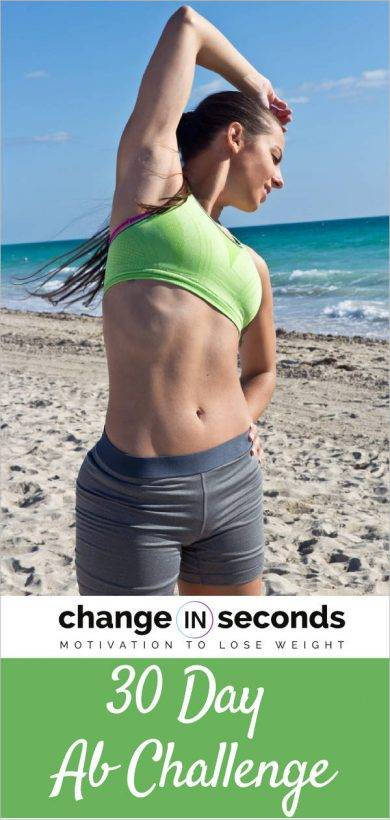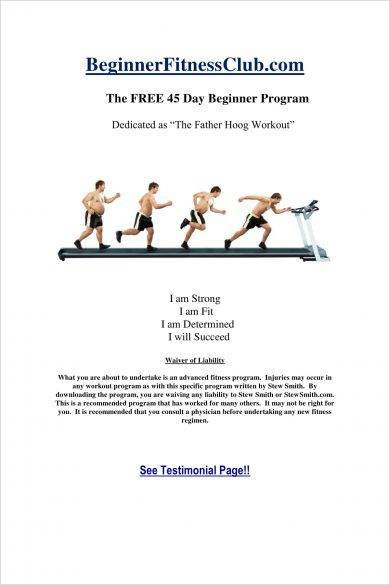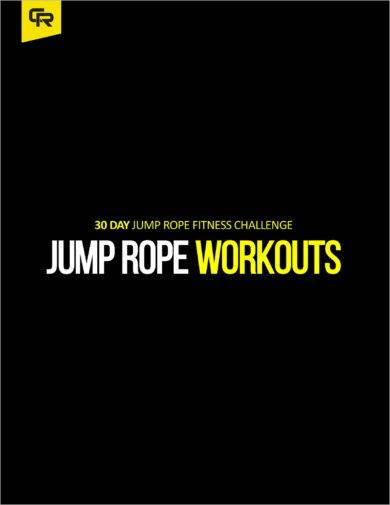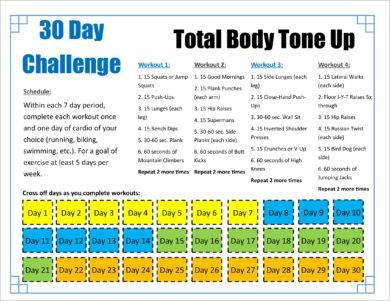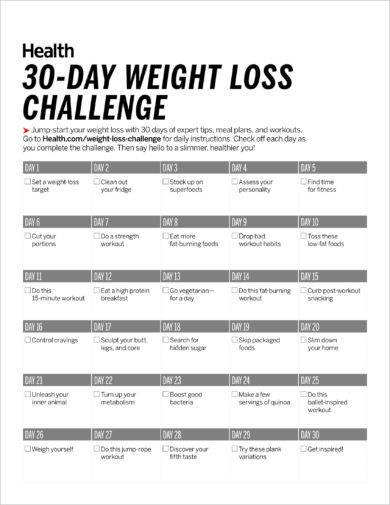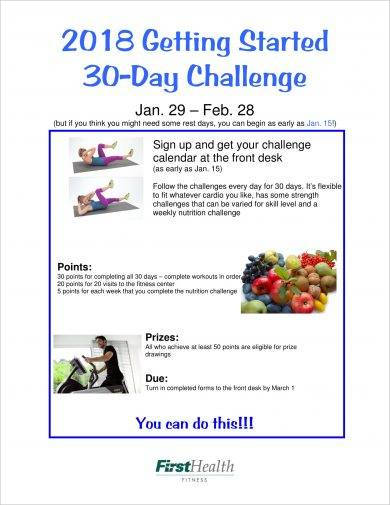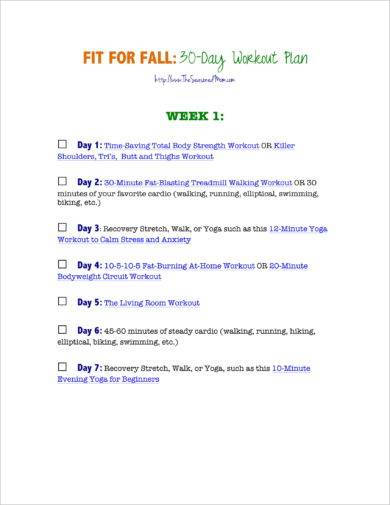10+ 30-Day Workout Plan Examples to Download
Having a balanced diet—eating go, grow, and glow food—is not enough to achieve a healthy lifestyle. You also have to condition your mind and improve your mental health, avoid excessive use of alcohol and tobacco, avoid addictive drugs, avoid high-risk sexual behaviors, and most importantly, constantly exercise your body. You may also see 30-day fitness plan examples.
Having a good workout will not only affect your physical health but will also improve your mental health. Despite hectic schedules in school or work, find time and discipline yourself to have a workout constantly, and you will surely be surprised of its positive impact to the overall wellness of yourself. You may also like 30-day weight loss plan examples.
When you are starting your workout plan, the first stages are said to be the most crucial ones since these stages will determine your determination of moving forward and do your workout or quit on the plan. To help you in your first days, you can refer to the different types of workout plans below and choose the type of workout that suits you. You may also check out 30-day meal plan examples.
30-Day Abs Workout Plan Example
30-Day Beginner Workout Plan Example
30-Day Jump Rope Workout Plan Example
Types of Exercise
Doing an exercise regularly does not only improve your physical health but also improve your mental and emotional health. Because working out releases toxins from your body, you will gain the confidence to walk with your head held high and you will feel relaxed and delighted. You may also see 30-day workout plan to lose weight examples.
The guilt from eating food with too much sugar and calories will be eradicated, and you will experience a radiating glow all around your body. Hence, exercising and working out really helps people a lot even in different ages.
There are different types of exercises according to their impact in our body, and they are as follows: aerobic exercises, strength exercises, stretching and flexibility exercises, and balance exercises. Detailed discussions on these types are presented below. You may also like 30-day meal plan for weight loss examples.
1. Aerobic Exercises
These pertain to the exercises that can get your heart rate up and make you breathe harder—those that involve your cardiovascular system. Common examples of aerobic exercises are running, swimming, and dancing. There are different types of aerobic exercises, and they are as follows:
Low Impact Aerobics
There are people who have some health problems or who have poor health condition, hence cannot perform high intensity workout. In this case, they must only perform low impact aerobics. This type of aerobic comprehends rhythmic movements together with the exercising of the large muscle groups. You may also see 90-day weight loss plan examples.
Water Aerobics
During the summer season, water aerobic exercises are very much preferable. This type of workout is done by doing aerobics literally on the water, preferably on a pool with enough water that could not drown the participants of the exercise. Many people believed this is an excellent method to burn out unwanted body flab. You may also like daily plan examples.
Step Aerobics
This type of aerobics is said to be a new version of aerobics, incorporating interesting steps such as the Pony or the Jazz Square, which are often done in four, two steps taking you in one direction, two more taking you the other direction.
Dance Aerobics
In this type of aerobics, the performer integrates exercise and dance movements into routines that are practiced with music. Ballet, jazz, and disco, and the common dance styles that are incorporated with exercise. This type of aerobics develop the muscle and flexibility as it also integrates stretching exercises. You may also check out academic strategic plan examples.
Sports Aerobics
This type of aerobic is a hard and competitive sport that integrates aerobic choreography and gymnastics elements. With this type of aerobics, an individual is trained to prevent himself or herself from the risks from doing sports or gymnastics while keeping the artistic quality and fun of doing aerobics. You might be interested in 60-day diet plans.
30-Day No Equipment Workout Plan Example
30-Day Ski Workout Plan Example
30-Day Total Body Tone Up Workout Plan Example
2. Strength Exercises
These are exercises that involve your musculoskeletal system being worked out by using resistance. It helps increases your lean muscle mass, an important factor for weight loss. Typical examples of strength exercises are weight lifting, push-up, and crunches. Below are the different types of strength exercises:
Agile Strength Exercise
In this type of exercise, the ability to decelerate, control, and generate muscle force in a multiplanar environment is improved. This exercise is helpful when you want to generate the force required to move objects from one location to another, to improve resiliency of the muscle and connective tissue to reduce the risk of injuries, and to enhance performance of specific sports or activities in our daily life. You may also see fitness journal examples.
Strength Endurance Exercise
This exercise improves the individual’s ability to maintain muscular contractions or a consistent level of muscle force for extended periods of time. It is useful in maintaining good postural stabilization for an extended period of time, improve the aerobic capacity of working muscles, and enhance ability to perform many functional tasks and activities in our daily life. You may also like workout log examples.
Explosive Strength Exercise
This type of exercise will help you produce a maximal amount of force in a minimal amount of time as this focuses on the speed of movement through a range of motion. This is important since this can help us reduce our reaction time and improve the resiliency of muscle and connective tissue. You may also check out diabetes action plan examples.
Maximum Strength Exercise
This will help you achieve your highest level of muscle force that can be produced. This requires high levels of neuromuscular efficiency to enhance both intra- and intermuscular coordination. This is important to increase the levels of muscle-building hormones and bone density and strength. You might be interested in 30-day diet meal plan examples.
Relative Strength Exercise
You can increase the amount of force generated per unit of body weight through this type of strength training, improving the magnitude of force production while maintaining or reducing total body mass. This can help you maximize motor unit recruitment and improve neuromuscular efficiency. You may also see weekly workout log examples.
Speed Strength Exercise
Speed strength pertains to the maximal force capable of being produced during a high-speed movement. Trained with either body weight or a minimal amount of resistance, this will allow your movement to become faster and to minimize your reaction times.
Starting Strength Exercise
This type of strength exercise will help you produce force at the beginning of a movement without momentum or a pre-stretch to load mechanical energy, improving the ability of muscle and connective tissue to increase the rate of force production and enhancing the ability to transition from seated to standing. You may also like exercise schedule examples.
30-Day Workout Weight Loss Plan Example
Complete 30-Day Workout Plan Example
3. Stretching and Flexibility Exercises
These exercises involve stretching your muscles to improve your range of motion at your joints, flexibility, and circulation. Not only that, it also reduces the risk of injury during your physical activities such as during sports. Examples of stretching and flexibility exercises include yoga, tai chi, and Pilates. Provided below are the different types of stretching and flexibility exercises. You may also see daily work log examples.
Static Stretching
This type of stretching involves stretching a body part to its farthest position and then holding it for a period of time, usually 30 seconds, but it could also be longer. The stretch is felt through the entire length and center of the muscle and not in the joints.
Passive Stretching
This is closely similar to passive stretching except that a tool or a partner will provide the force to stretch the muscle to its farthest possible stretch. It relieves muscle spasms, and it also helps reduce muscle fatigue and soreness after a workout or an exercise. You may also like workout log Excel examples.
Dynamic Stretching
In this type of stretching exercise, this involves controlled swinging of the arms and legs that gently takes them to the limits of their range of motion. The parts of the body that are being stretched are moved with a gradual increase of the speed, reach, or both.
Ballistic Stretching
This stretching exercise involves forcing a part of the body to go beyond its normal range of motion by making it bounce to a stretched position. It can help increase the range of motion, and it can also trigger the muscle’s stretch reflex. However, this exercise can make you more susceptible to injury; hence, only highly conditioned and competent athletes preparing for strenuous activities should perform it. You may also check out weekly plan examples.
Active Isolated Stretching
This type of stretching is the most commonly used stretching by athletes, trainers, massage therapists, and other professionals. In order to perform this exercise, you need to reach a certain position and hold it steady without any assistance other than the strength of your own muscles. You might be interested in advertising plan examples.
Isometric Stretching
This type of stretching exercise involves the muscles stretched into a position and resisting the stretch. This is considered to be the safest and most effective method of increasing the range of motion of the joints. It also strengthens tendons and ligaments while retaining their flexibility. You may also see implementation plan examples.
Proprioceptive Neuromuscular Facilitation
This type of exercise combines isometric, static, and passive stretching to foster a high level of flexibility. It is performed by passively stretching a muscle, isometrically contracting it against resistance in the stretched position, and passively stretching it through the resulting increased range of motion. You may also like training plan examples.
4. Balance Exercises
As the name suggest, balance exercises are those exercises designed to improve the balance of your body. It also improves your ability to control and stabilize your body’s position. Standing on one leg, walking heel to toe in a straight line, and leg lift with dumbbells are the common examples of balance exercises. It has different types which are as follows:
Static Balance
In this type of balancing exercise, the individual must stand in one place without moving the feet. This helps improve steadiness when performing the different activities our daily living such as washing dishes, preparing tasty meals, and getting dressed.
Static Balance and Weight Shifting
Another type of balancing exercise is the static balance plus weight shifting. Static balance is explained previously, and this will be incorporated with weight shifting, that is, the movement of the body’s center of mass from one foot to another without moving the feet. You may also see quality plan examples.
Dynamic Balance
Dynamic balancing exercise involves the standing and moving about and stepping from one place to another. Walking in parallel bars, stair climbing, and stepping over obstacles are the common examples of dynamic balancing. You might consider including reactions to this exercise such as throw and catch, start and stop, simulated slip or trip, and nudges. You may also like management plan examples.
Detailed 30-Day Workout Plan Example
Fit for All 30-Day Workout Plan Example
Quick Summary
Our body needs to be constantly active by doing different workouts designed for specific areas in our body. In general, there are four broad categories of workout or exercise, namely aerobic exercise, strength exercise, stretching and flexibility exercise, and balance exercises. You may also check out action plan examples.
Aerobic exercises are those activities that involve your cardiovascular system. The different types of aerobic exercises include low impact aerobics, water aerobics, step aerobics, dance aerobics, and sports aerobics.
Strength exercises involve movements and stability of your musculoskeletal system. The different types of strength exercises are agile strength exercise, strength endurance exercise, explosive strength exercise, maximum strength exercise, relative strength exercise, speed strength exercise, and starting strength exercise. You might be interested in work plan examples.
Stretching and flexibility exercises are performed to improve your range of motion, flexibility, and circulation. Static stretching, passive stretching, dynamic stretching, ballistic stretching, active isolated stretching, isometric stretching, and proprioceptive neuromuscular facilitation are the different types of stretching and flexibility exercises. You may also see strategic plan examples.
Balance exercises, undoubtedly, are those exercise designed to improve your balance. The types of balance exercises are static balance, static balance and weight shifting, and dynamic balance exercises.
Improve your health and lifestyle now and choose a workout plan that’s best for you through the examples of 30-day workout plan presented above.



